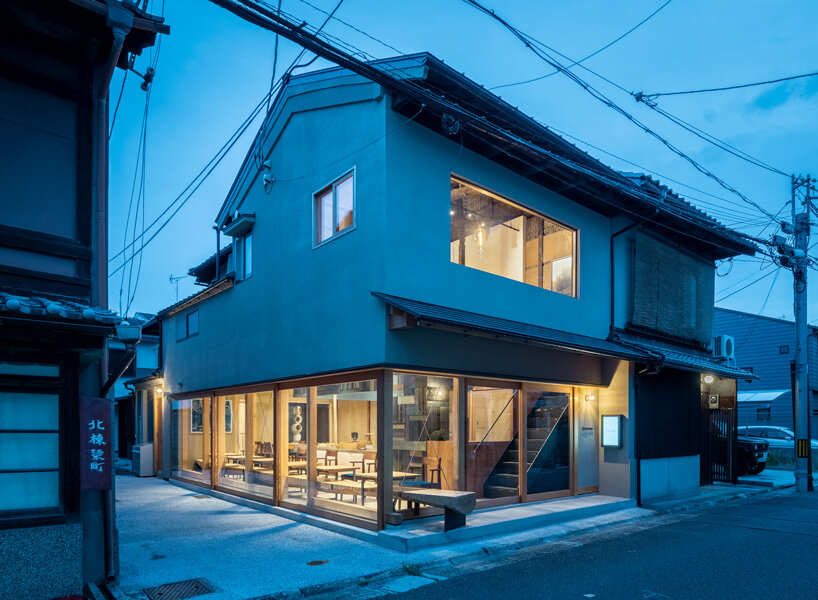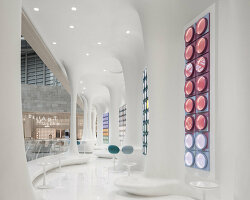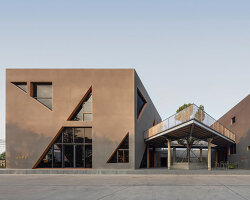a ‘cozy stopover’ for travelers in Kyoto city
Coil Kazuteru Matumura‘s latest project sees the renovation of a traditional Japanese townhouse into a ‘cozy stopover’ for travelers in Kyoto city. Located just a 5-minute walk from Kiyomizu Gojo Station, the ‘Kyoto Wand’ occupies a corner plot that faces a wide road, inviting tourists to unwind and have a break from their culturally busy day. Kyoto City is a popular travel destination and an ideal mountainous environment for sports activities. With this project, the design team sought to enrich travelers’ stay in the city, offering them a welcoming place for relaxation where they can exchange information and experiences. ‘Kyoto Wand’ is a gathering place that serves food and drinks but goes beyond a typical café as it provides facilities like showers, and lockers, where people can freshen up and store their belongings. 
all images by Yoshiro Masuda
‘Kyoto Wand’ is more than just a typical café
Construction-wise, the original structure had passed through several renovations, so the team had to strip it down to the initial structure. They worked on repairing, reinforcing, and revamping the building to form a cozy place that celebrates the elegant Kyoto townscape. The project was planned with careful attention and consideration for a harmonious balance between repair and reinforcement, as well as renewal only where it was required. Towards the exterior, the design team removed the ruined tiled façade while restoring the eaves of the roof and reforming the connection with the neighboring houses. Floor-to-ceiling openings pierce the corner building extending the boundaries between in and out and creating a visual connection to the surroundings. In certain seasons, the sliding doors can be opened, shaping a semi-open living area. Along the driveway, carpenter Masaaki Okimoto constructed a bench made of half-sawn chestnut logs achieving a strong natural material feel.
Once entering the structure, a reception area takes shape, after which one will meet the kitchen, a pickup counter with a return tray area, a bench with side seating, and a table for four in front of a small garden. A restroom, lockers, and shower room are gathered at the back of the building. For the Japanese studio, ‘Kyoto Wand’ unfolds as a meeting hub where people with diverse backgrounds meet up and interact. ‘We envision this to be a gathering place, much like a bay area, taking in the flow of the city’. 
a perfect juxtaposition between handiwork and industrial parts
a perfect juxtaposition of handiwork & industrial aesthetics
When it comes to materiality, the architects exploited the existing beams, pillars, and earthen walls, giving them new life in age-old expressions. The indigo-dyed wood panels are symbolically placed in the center decorating the kitchen area. The dyeing of these wooden panels was realized with the collaboration of artist Yuko Yamamoto, who specializes in dyeing plants and trees. The wall surface stands out with its uneven dyeing condition, resulting in a pattern-rich presence. Traditional Japanese washi paper was applied to the counter, changing its texture to a unique piece of art. Trivalent chromate steel sheet is used as a finish for the ceiling and walls inside the kitchen, which is a film treatment normally used for invisible parts of industrial products. The color of the material changes depending on the angle of view. The combination of the craftsman’s handiwork and the industrial parts creates a perfect juxtaposition of the eccentric materials.
The upper floor takes shape between the existing beams and the attic, covered by new white walls. This level usually acts as a more secluded seating area. The tables and chairs can be disassembled and stacked for easy storage in the warehouse. The area can double as an event space for gallery exhibitions, thus reflecting notions of the artist’s work. In collaboration with a group of artists and designers, the team enhanced the interior, adding a more artistic overtone. Pendant lighting shades by glass artist Ryo Sekino hover above the staircase; pendant lighting shades by Takayuki Daikoku are installed in the garden, sculptures by Takayuki Daikoku are also found there, and photographs by Yasumi Kakimoto are hanging on the walls. The furniture, including the tables and chairs on the first and second floors, was designed by Naomi Toda of Potitek. The bookshelves and countertop fixtures were created by Yuto Sasaki of Lenogu.
 a wall surface rich in expression is the protagonist of the kitchen
a wall surface rich in expression is the protagonist of the kitchen

 indigo-dyed wood panels are symbolically placed in the center framing the kitchen area
indigo-dyed wood panels are symbolically placed in the center framing the kitchen area

 the new features are thoughtfully embedded in the above-existing structure
the new features are thoughtfully embedded in the above-existing structure







 a bench made of half-sawn chestnut logs
a bench made of half-sawn chestnut logs
project info:
name: Kyoto Wand
architect: Coil Kazuteru Matumura Architects
construction: Kisaburo
location: 311-1, Kitatoryo-cho, Higashiyama-ku, Kyoto, Japan
status: completion July 2022
front road width: 4.6 m
site area: 75.85 sqm
building area: 64.69 sqm
total floor area: 105.34 sqm
floor area of 1st floor: 64.69 sqm
floor area of 2nd floor: 40.65 sqm
photography: Yoshiro Masuda

























